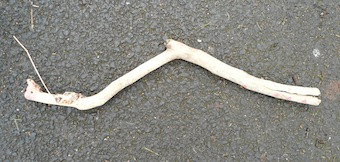“Be careful what you wish for because it may come true”
(Proverb)
Celtic folklore exists about the use of wishing rods which are found tied to beech trees. The beech tree is also known as the tree of wishes. Fallen beech branches are said to be invitations from the wishing fairies. You can write a wish on a branch and stick it into the ground. It will be collected by a fairy and taken to the Fairy Queen for consideration.

In my school grounds, mature beech trees can be found bordering two sides of the boundary fence. It is the one tree species we have. So naturally I was intrigued by this folklore and decided to give it a go with one class.
Alas the activity went a little haywire for various reasons. So the whole thing did not turn out as planned although some children did write their wishes on some sticks. I had hoped to get the children to look for fallen beech sticks as this is a natural starting point. However we ended up using the sample sticks I had brought in.
We used deco acrylic marker pens which work well on many different surfaces.
The next task was to stick the rod into the ground. I decided this would need some thought and attention. I was particularly inspired to do this by my visit last weekend to the Yorkshire Sculpture Park.
“You cannot simply put something new into a place. You have to absorb what you see around you, what exists on the land, and then use that knowledge along with contemporary thinking to interpret what you see.”
Tadao Ando
One child decided to place hers within the school grounds. The others wanted to take their wishing sticks home with them. So we will have to wait and see if any of the wishes come true.
I discovered this folklore and a bit more as a result of one sculpture at the Yorkshire Sculpture Park, if you take a walk along Oxley Bank through the ancient woodlands, you come across a very subtle piece of artwork. I would have missed it, had it not been for a sign which told me what was ahead. As you can see in the photo below, it just looks like an ordinary worn woodland path in winter, with a few tree roots sticking out of the surface.
Upon closer examination, the roots look part and parcel of the environment. Like any other beech roots. Except they aren’t. These are bronze castings of the roots of a fallen beech tree in the wood which have been placed here, by Hemali Bhuta, an Indian artist with a background in interior design from Mumbai. When you prod them with your foot, you realise something is not quite right.
According to folklore, the roots of beech trees look like snakes, which are a symbol of wisdom and rebirth in Celtic mythology. The photo below makes you realise just how snake-like these roots are. The way the bronze roots have been placed, they also serve as speed brakers, causing passers by to slow down lest they trip.
The video clip below is well worth watching and explains Hemali’s reasons for creating this artwork. She wanted a subtle intervention which would catch the eye rather than dominate the landscape. The use of bronze is a reminder of the Bronze Age, traces of which are layered in the earth.
So, if you are passing a beech tree, who knows, perhaps you too can find a fallen stick and make wish too. And slow down as you negotiate their surface lateral roots…





















The Yorkshire sculpture park is 5 minutes from my house I must go and look for this one now
Oh yes – it’s the other side of the lake to the main entrance. So it’s a bit more of a walk than most of the sculptures.
Hiw interesting, thank you for the education on the folk lore. Let us know if they come true
How fascinating, I’m sure the children loved the idea of the fairies taking their wishes. What a lovely place to visit. Thank you for linking to Country Kids.
thats a lovely idea isnt it to make wishes on sticks. really sweet idea x
I love the idea of wishing sticks and was obsessed by fairies and Enid Blyton fairy stories in particular when I was young so this really captured my imagination 🙂